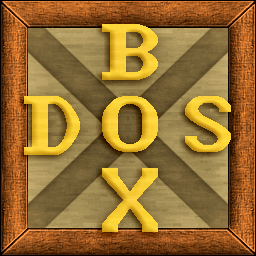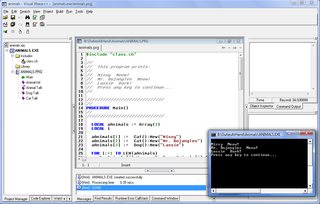
WordStar is a word processor application for microcomputers. It was published by MicroPro International and originally written for the CP/M-80 operating system, with later editions added for MS-DOS and other 16-bit PC OSes. Rob Barnaby was the sole author of the early versions of the program.
XyWrite is a word processor for MS-DOS and Windows modeled on the mainframe-based ATEX typesetting system. Popular with writers and editors for its speed and degree of customization, XyWrite was in its heyday the house word processor in many editorial offices, including the New York Times from 1989 to 1993. XyWrite was developed by David Erickson and marketed by XyQuest from 1982 through 1992, after which it was acquired by The Technology Group. The final version for MS-DOS was 4.18 (1993); for Windows, 4.13.

FreeDOS is a free software operating system for IBM PC compatible computers. It intends to provide a complete MS-DOS-compatible environment for running legacy software and supporting embedded systems.
dBase was one of the first database management systems for microcomputers and the most successful in its day. The dBase system included the core database engine, a query system, a forms engine, and a programming language that tied all of these components together.
Clipper is an xBase compiler that implements a variant of the xBase computer programming language. It is used to create or extend software programs that originally operated primarily under MS-DOS. Although it is a powerful general-purpose programming language, it was primarily used to create database/business programs.
xBase is the generic term for all programming languages that derive from the original dBASE (Ashton-Tate) programming language and database formats. These are sometimes informally known as dBASE "clones". While there was a non-commercial predecessor to the Ashton-Tate product, most clones are based on Ashton-Tate's 1986 dBASE III+ release — scripts written in the dBASE III+ dialect are most likely to run on all the clones.

A COM file is a type of simple executable file. On the Digital Equipment Corporation (DEC) VAX operating systems of the 1970s, .COM was used as a filename extension for text files containing commands to be issued to the operating system. With the introduction of Digital Research's CP/M, the type of files commonly associated with COM extension changed to that of executable files. This convention was later carried over to DOS. Even when complemented by the more general EXE file format for executables, the compact COM files remained viable and frequently used under DOS.

DOSBox is a free and open-source emulator which runs software for MS-DOS compatible disk operating systems—primarily video games. It was first released in 2002, when DOS technology was becoming obsolete. Its adoption for running DOS games is widespread, with it being used in commercial re-releases of those games as well.
Paradox is a relational database management system currently published by Corel Corporation.
Virtual DOS machines (VDM) refer to a technology that allows running 16-bit/32-bit DOS and 16-bit Windows programs when there is already another operating system running and controlling the hardware.

Multiuser DOS is a real-time multi-user multi-tasking operating system for IBM PC-compatible microcomputers.
In computing, Windows on Windows was a compatibility layer of 32-bit versions of the Windows NT family of operating systems since 1993 with the release of Windows NT 3.1, which extends NTVDM to provide limited support for running legacy 16-bit programs written for Windows 3.x or earlier. There is a similar subsystem, known as WoW64, on 64-bit Windows versions that runs 32-bit programs.
VDMSound was an open-source emulator of legacy sound card devices, designed to allow video games and other applications written for MS-DOS to run on the Microsoft Windows NT/2000/XP/95/98/Me operating systems. Its author is Vlad Romascanu.

The shapefile format is a geospatial vector data format for geographic information system (GIS) software. It is developed and regulated by Esri as a mostly open specification for data interoperability among Esri and other GIS software products. The shapefile format can spatially describe vector features: points, lines, and polygons, representing, for example, water wells, rivers, and lakes. Each item usually has attributes that describe it, such as name or temperature.

Xbase++ is an object oriented programming language which has multiple inheritance and polymorphism. It is based on the XBase language dialect and conventions. It is 100% Clipper compatible language supporting multiple inheritance, polymorphism, object oriented programming. It supports the xBase data types, including Codeblocks. With Xbase++ it is possible to generate applications for Windows NT, 95, 98, Me, 2000, XP, VISTA and Windows 7, 8, 10.

The Sun386i is a discontinued hybrid UNIX workstation/PC compatible computer system produced by Sun Microsystems, launched in 1988. It is based on the Intel 80386 microprocessor but shares many features with the contemporary Sun-3 series systems.
Criticism of Windows XP deals with issues with security, performance and the presence of product activation errors that are specific to the Microsoft operating system Windows XP.
Paperback Software International Ltd. was a software company founded in 1983 by Adam Osborne to manufacture discount software such as word processor Paperback Writer and related spell checker Paperback Speller, spreadsheet VP-Planner, database VP-Info, and the VP-Expert artificial intelligence software. VP-Expert was developed by Brian Sawyer The company was headquartered in Berkeley, California.

PCPaint was one of the first IBM PC-based mouse-driven GUI paint programs, released in 1984. It followed after Microsoft Doodle, released in 1983 with the Microsoft Mouse version 1 drivers for DOS, and around the same time as Digital Research’s Draw program. It was developed by John Bridges and Doug Wolfgram. It was later developed into Pictor Paint.
Tao ExDOS is an emulator software application designed to allow users of old MS-DOS applications to run these applications on new operating systems such as Windows 10, Windows 8, Windows 7, Windows Vista, Windows XP, Windows 2000, and Windows Terminal Server.








